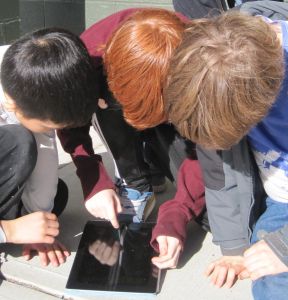One way Canada and India are different is that for millennials, a university degree from abroad means they stay abroad. Most Canadian kids go to undergraduate school in Canada. Even if they go away for school, they tend to come back. Our guide’s only child, a son, studied in France. Now he lives in Amsterdam and doesn’t want to come back home.
The younger generation in Agra, we are told, is angry. Agra’s economy is based on the Taj Mahal (translation: “Crown Palace”). 7 million tourists per year flock to the city, but pollution from nearby industry was wreaking havoc on the monument. So the government closed all industry. Now these factory workers are jobless. They don’t want to “go back” to what their parents do or did, and they’re not skilled enough for office work. Traditional means of making a living are dying out, and the old ways are dying. Here’s an example. The Taj is constructed of white marble that has been carved and inlaid with semi-precious stones. The intricacy of this work is stunning. In the right light some of the translucent stones sparkle. Many tiny pieces of stone can be required to craft one petal or one leaf. This craft is still performed only in Agra in the same way as in the 1600’s. No where else in India. But the children of these artisans are not learning from their fathers, so the skill may die with them.
Things change, of course. But a craft that’s existed for 350 years, that adorns one of the world’s most famous wonders…that knowledge and skill could just vanish? It seems wrong to me. 

We saw the Taj on a Tuesday. The previous Saturday 100,000 people queued in lines that snaked for 2.5 hours to enter the complex. Then another 2.5 hours to enter the Taj itself. So there’s no question it holds a fascination for Indians and people the world over.
The story we were told went something like this: Shah Jahan’s most favourite wife of 19 years, Mumtaz Mahal, was dying after giving birth to their 14th child. When she realized the end was near, she called her husband to her side and asked for three things. She thanked him for the love and devotion he had shown her, she asked him to look after their children, and she asked him to build her a memorial to her memory. 22 years of construction, funded off the hard work and tithes of the poor, voila. I said to our guide, as beautiful and amazing at the Taj is…when I see things like this in the world, this is the only time I am truly interested in time travel. To talk with the people who were working on the Taj. Imagine if you could ask them what they thought of it? How was the Shah received? Did they resent the taxes on their hard work paying for the construction? Or were they proud of it…did it inspire and lift them up as it does for us today? Did they feel they were part of something bigger than themselves?
I am told by our guide in his 28 years of bringing people from all over the world to the Taj, that it inspires the entire range of human response. People cry. People come on their honeymoons. They come on their wedding anniversaries. This tomb for a loved wife is the ultimate expression of a husband’s love. For me, besides being in awe of the structure itself…its symmetry, its grace, how it becomes more beautiful the closer you get to it…it gave me a feeling of peace. Sometimes when famous things are turned into a tourist attraction, something is lost. In being a tourist space, it isn’t what it was before. I felt that way at the pyramids of Giza, perched at the outskirts of sprawling Cairo. Not that they aren’t amazing. They are. But like a bad actor who can’t get beyond their own persona to really show us the character their story inhabits, I didn’t see the pyramids for what they were; I saw what they were trying to be and what I was told they were. I saw them as the last suburb of Cairo with the smog, the traffic and the apartment buildings as their backdrop.
I think the reason 7 million people every year aren’t wrong is because the Taj still delivers. Whether you weep, whether you linger in the gardens and just quietly take it in, or whether you think about it later. Whether you marvel at the skill that created it and the human capacity to create beauty. This wonder of the world gives you something. It doesn’t take something from you. It doesn’t try to sell you something or make you remember it. Oh but I will remember it. And I when I wrap my pink scarf around me another time, there is another special memory with it. Watching the sunrise over the Taj Mahal, check. Pink scarf making me more fashionable while doing so, check.




sounds like you are having an amazing time. It’s a complex and fascinating place, that’s for sure.
Hi Carmen. Enjoyed the read……thank for sending it.
Lovely to hear from you Lorna. India is a fascinating place.